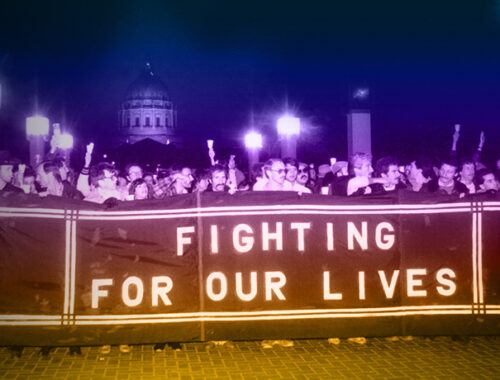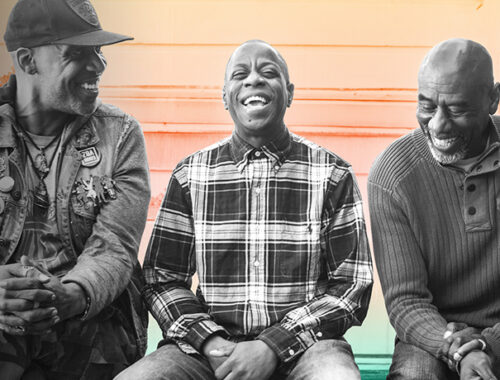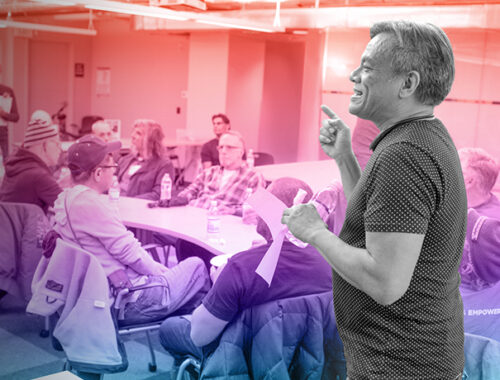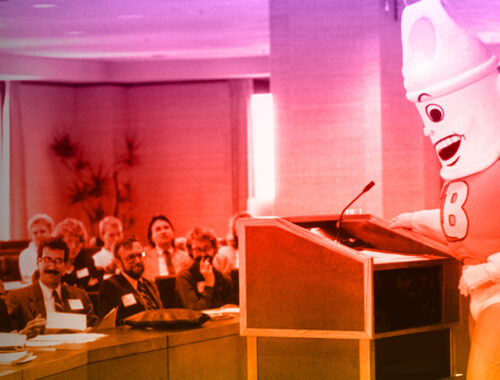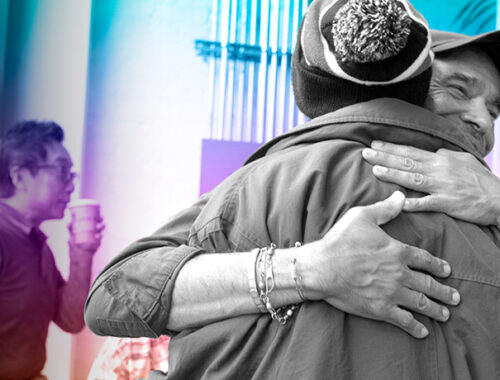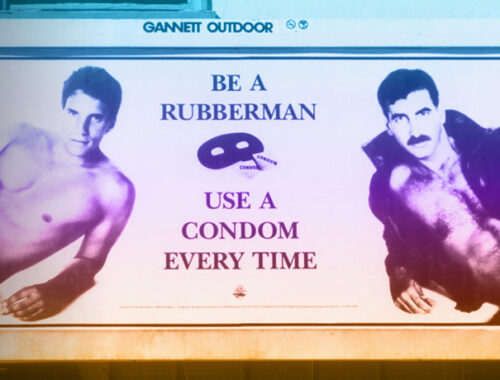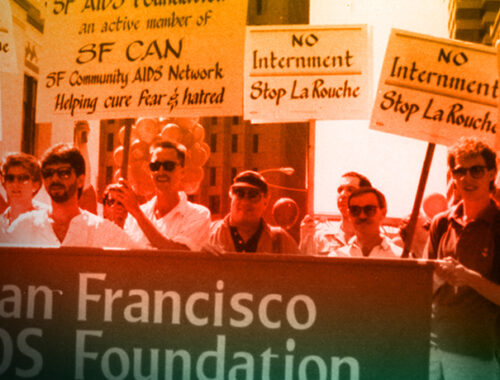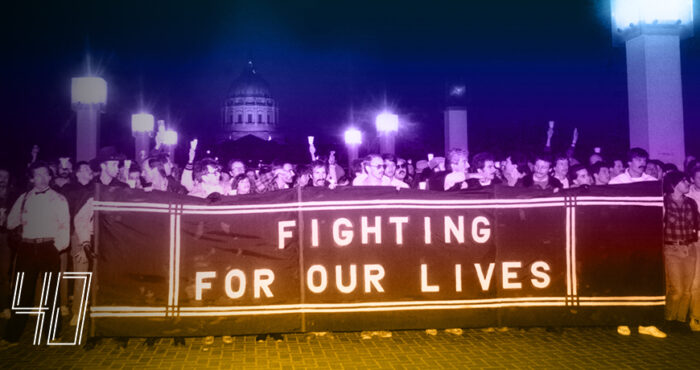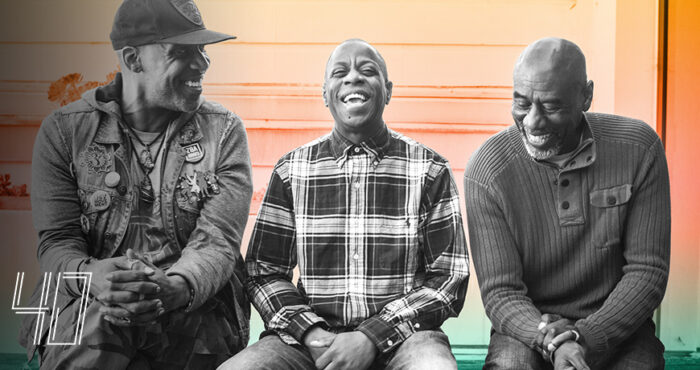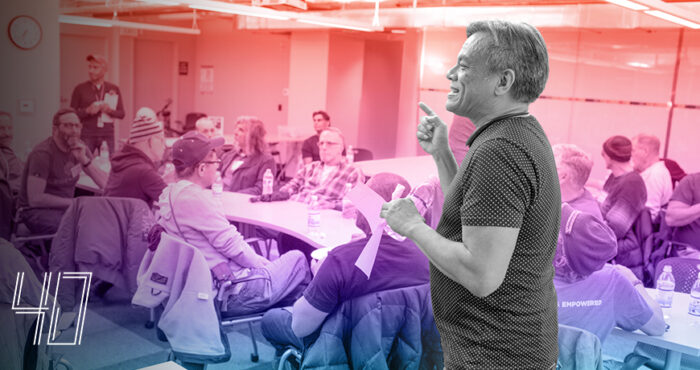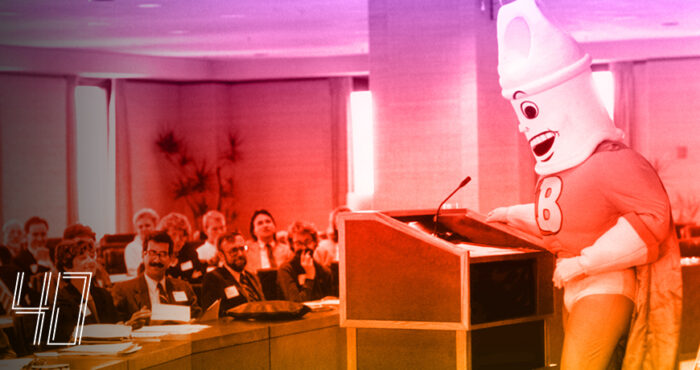From Civil Disobedience to Public Health
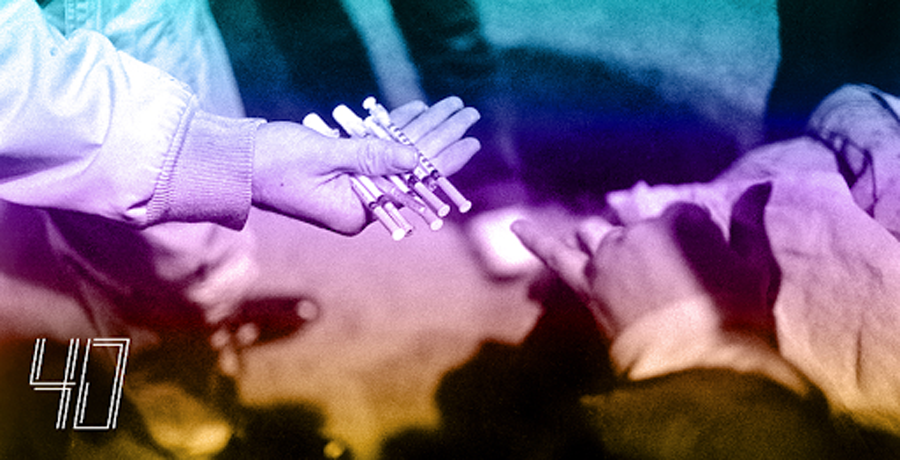
This article was produced in honor of San Francisco AIDS Foundation’s 40th anniversary, which we are commemorating in 2022.
Over the years, San Franciscans have taken bold action to bring the needs of people who inject and use drugs to the forefront of our HIV prevention response. In the early years of the HIV epidemic, San Francisco’s first needle exchange program operated against the law by a team of volunteers passing out syringes and safe injection supplies from a baby carriage on the streets of San Francisco. Today, we embrace a comprehensive harm reduction approach to meet people who use drugs with services, information, resources, and advocacy.
Prevention Point Needle and Syringe Exchange
Early on in the HIV epidemic, it became clear that people injecting drugs were at risk of developing what would come to be known as HIV and AIDS. But the political will needed to address infections happening among people using drugs didn’t follow–and in fact, actively worked against efforts to keep people safe and save lives.
“There was plenty of prejudice to go around,” said Bonnie Fergusson,” a leader in the harm reduction movement in San Francisco. “People who might be expected to do something effective about it weren’t willing to touch the issue because it had to do with drug users. Meanwhile, the virus was spreading pretty quickly.”
In the early years of HIV, federal and state laws prevented the sale and possession of “drug paraphernalia,” including syringes, making it illegal for organizations to prevent the spread of infectious disease by distributing syringes. The concept of “harm reduction”–empowering people with the tools and information they need to reduce harms from drugs–“wasn’t part of the lexicon at the time,” said Mike Shriver, former Health Commissioner for San Francisco and long-time HIV activist.
Early in the 1980s, Fergusson worked at the Haight Ashbury Free Medical Detox Clinic, seeing people with a history of injection drug use who were just starting to get sick with HIV and AIDS. She remembers hearing from people who said it was common to share syringes with up to 30 other people in a month. New syringes were hard to come by.
Activists and allies realized they needed to step up and fill the void in order to save lives. By 1988, a group of fifteen health workers, people with a history of drug use, and activists, including Fergusson, were talking about how to begin a needle exchange in San Francisco.
Cobbling together what few resources they could gain access to, they began doing outreach in the Tenderloin and SoMa neighborhoods. Naming their fledgling program Prevention Point, this volunteer-led group operated underground for months, risking arrest in order to bring syringes and other safer injection supplies to the community in a baby buggy.
The founders of Prevention Point included: Raven Moonshadow, Jeff Yippee, Moher Downing, Luis Kenmitzer, Rose May Dance, George Clark, Bill Simpich, Rosemary Prem, Trish Case, Bonnie Fergusson, Marion Doub, Bob Thawley, Jim Haber, Hilary McQuie, Donny Gann, with Tia Wagner joining within the first few months and many others joining in subsequent years.
“The very first crew doing needle exchange wanted to call attention to the fact that many, many injectors were saying, ‘I wouldn’t have HIV if I had had clean works. I would have shot with clean works,’” said Shriver. “Since our goal really was about saving lives, and protecting people’s health, harm reduction made a lot of sense to us.”
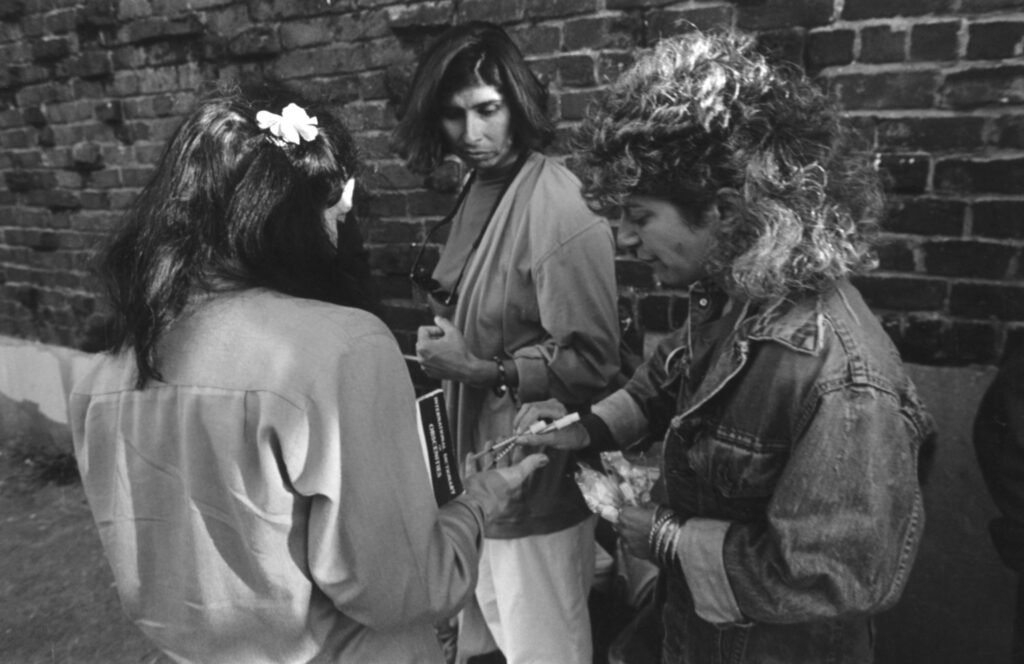
The chief of police at the time, Frank Jordan, made an agreement with the mayor and the head of the San Francisco Department of Public Health that the police wouldn’t purposefully go after people operating needle exchanges, but volunteers still faced risk of arrest.
“Jordan’s position was, ‘We’re not going to go out chasing after volunteers. But if someone calls us to complain, we have to respond,’” said Fergusson. “So for the first few years, anytime someone would make a call about us, the cops would show up. They would confiscate the needles, which was the worst part, and then would take us down to 850 Bryant to make sure we didn’t have any outstanding warrants. We usually would get a ticket.”
In the early years, Prevention Point relied on supplies diverted from one members’ workplace at a healthcare setting, local community fundraisers, donations from community members and gay pride marches, and the goodwill of neighbors and friends to keep the needle exchange operating in the community. The volunteer group struggled along for five long years before city funding, and political and public support came their way.
Legalizing needle exchange in San Francisco
Pat Christen, the executive director of SFAF from 1989 to 2004, remembers confronting the problem of how the Foundation would do needle exchange in San Francisco early in her tenure.
“At the time, needle exchange in San Francisco, in California, in the US was entirely illegal. I just remember thinking, ‘How are we going to do this?’ We weren’t interested in having needle exchange continue to operate underground. We didn’t know yet how to legalize it, and we didn’t have time to wait to pass state legislation. So, we sought guidance from the City Attorney’s office and from Kathy Fisher at Morrison and Foerester to help us figure out how to do this work legally, how to address tax liability issues for people wanting to donate to support needle exchange, and how to get public and private resources to flow legally to support this work. We convened a small group–attorneys, tax experts, policy experts, needle exchange advocates from Prevention Point–to work the problem.”
San Francisco AIDS Foundation successfully advocated for the City to declare a state of emergency in order to sanction needle exchange in 1993, but it was a hard-won victory.
“When we initially suggested doing needle exchange at the Health Commission, there was a lot of pushback. Commissioners shouting, community members were shouting back,” said Christen. “We testified respectfully and with substantial evidence about the efficacy of exchange, but different members of the Health Commission remained incensed for some time. It was a very, very contentious issue, despite the evidence. We knew we would slow the spread of HIV by doing needle exchange, but I think, understandably, people were anxious about what it might mean in terms of promoting drug use, especially in neighborhoods and within families that had been ravaged by substance use.”
“There was a good deal of pushback from people on the Health Commission at the time,” said Shriver. “They didn’t want needle exchange in the Black community, didn’t want it in the Tenderloin, and thought we were just going to be encouraging and enabling drug use. And we just had to keep saying, ‘We’ve got the data. We’ve got data from the Swiss, from Seattle, and emerging data showing a drop in hep C rates.’”
Christen said that she, and other SFAF staff and needle exchange advocates from Prevention Point spent a lot of time meeting with community members at churches and other neighborhood groups to answer questions and make sure people had their concerns addressed. They continued to press for the Mayor, Health Commission, and Health Director to take action on the issue.
One major concern for the Foundation was the possibility of interference by the state or federal government. “Technically, within the confines of San Francisco, needle exchange became legal once the state of emergency was declared,” said Christen. “But we were concerned that the conservative state attorney general at the time–Dan Lungren–might try to shut the Foundation down.”
For this reason, SFAF established a separate 501(c)(4) entity–the HIV Prevention Project (HPP) to separately house the needle exchange programmatic work conducted by the all-volunteer Prevention Point once the emergency order was declared. In 1993, Prevention Point officially became part of HPP and needle exchange operated legally in San Francisco, with both private and public support to follow. This was to become a model for counties across the state and around the country.
“Having Prevention Point subsumed by SFAF was one of the bravest things I’ve ever seen,” said Shriver. “The Foundation really saw the need to make sure this intervention was out there, and they–under Pat Christen’s direction–invested in trying to find a way to get needle exchange programs legitimized through public policy–at the state level, at the local level with the health commission, and with the mayor and board of supervisors. Slowly, but surely, and faster than almost any other place in the country, San Francisco made that leap of faith. And it had such a profound impact on our epidemic here in the city.”
Expanding needle exchange, syringe access, and services for people who use drugs
Fernando Aguayo-García experienced the shift from Prevention Point, the all-volunteer needle exchange, to HPP with San Francisco AIDS Foundation. He volunteered with Prevention Point at a site in the Mission in the early 1990s, but then applied for a position with HPP once the program was established.
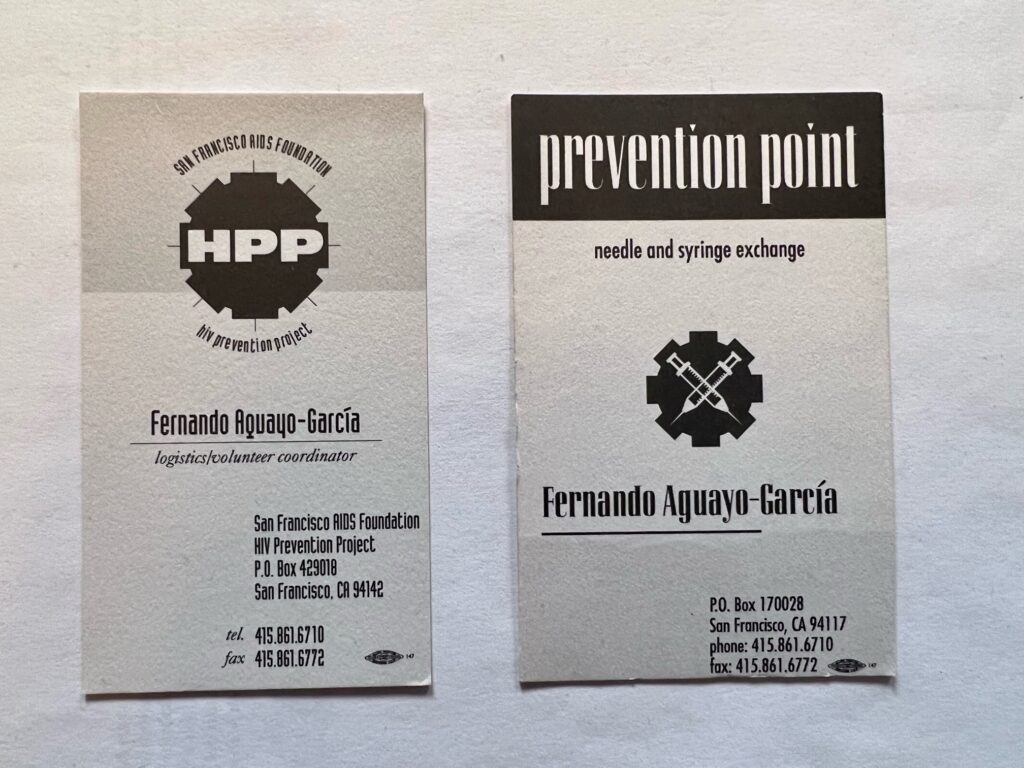
“There were only three staff in 1993–our executive director George Clark, an office administrator, and me,” said Aguayo-García. Aguayo-García was the logistics and volunteer coordinator from 1993 to 1997–in charge of building up the infrastructure and organization of the growing program.
“I remember we went and got this great big blue van–sort of like a newspaper delivery truck–that we used for outreach,” he said. “There was nothing inside, so we were able to customize it with shelves and everything we needed. At the time, we had three sites, which by the time I left was expanded to 11 different sites across the city.”
Aguayo-García said that ensuring quality and consistent services for clients–even during bad weather, and holidays–was his main priority. “The original group of volunteers established a great program, but there were some challenges to the services. They didn’t have funding, they were getting harassed by the police and by neighbors. So by the time the program became legit, it was our job to just build it up and make sure that everything worked really fluidly. We did great work, and I’m really proud of that,” he said.
HIV Prevention Point quickly became the largest needle exchange in the nation, and the program inspired other needle exchanges in the area and across the U.S. In 2000, California passed legislation allowing needle exchange programs to operate legally if local jurisdictions declared a state of emergency. But the road forward wasn’t always clear, and people working in the field at the time say that there were growing pains as the organization evolved and as needle exchange became more widely accepted.
“It was interesting and challenging to grow as an organization during this time,” said John Mullen, who volunteered with HPP in 1997 and then worked on staff from 1998 to 2006. We began as a grassroots organization rooted in activism, but then grew to a consistently-funded public health organization that required more oversight, accountability, and community buy-in. The goal was always to offer a program for injection drug users that was rooted in dignity and respect, but also to become a non-controversial public health program. It was always two steps forward, one step back. But I think the program did eventually get buy-in from people of all walks of life in San Francisco.”
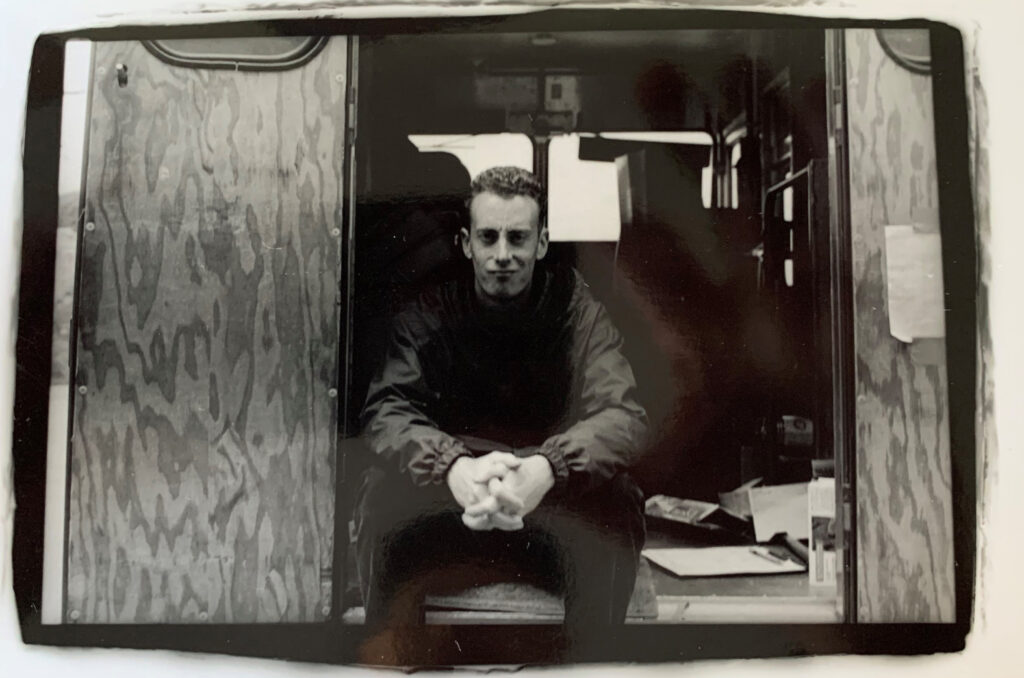
“Over time, I saw harm reduction become more mainstream, said Nina Grossman, who directed HIV Prevention Point from 1999 to 2006. “San Francisco really was on the forefront of this work back then. We led the way for so many other communities. We were a real leader in this field, and San Francisco AIDS Foundation established the baseline for how this can work.”
The effect on HIV prevention was clear: the number of new AIDS cases among people who injected drugs reached a peak in 1992 with 212 cases; six years later, that number dropped by half. Since then, the number of people who inject drugs who are diagnosed with HIV in San Francisco remains low due to the city’s wide adoption of syringe access programs and harm reduction practices.
“The way we did the needle exchange, the way we grew it, the way we educated people about it was very, very effective and smart. And I think we saved a lot of lives,” said Fergusson.
Over time, the program evolved to better fit the needs of the community. Grossman remembers when the program pushed agency leaders to allow for distribution of more than five-to-one at the needle exchange.
“We went from one-to-one exchange to five-to-one exchange. But then we found out that five syringes was nowhere near enough. We just started asking people, ‘What would work in your lives?,’ and it came out that basically people needed about 20 at a time, whether they had any to give back or not. Eventually, we were able to provide that to our participants.”
Mullen remembers a few notable changes to the program over the years, including bringing some sites indoors in order to provide more robust medical care, dispensing Narcan (an overdose prevention medication) when it became available, installing syringe “drop boxes” around the city for safer disposal, and beginning a site in the Bayview, a historically Black neighborhood in San Francisco.
“We were very consistent–that was the number one thing, and we always advocated for services that would be best for the people we saw,” said Mullen, when asked about the impact and success of the program over the years. “When you use drugs, your life can be kind of inconsistent, so we just needed to be there for people. We worked really hard to make it happen, and we had a lot invested. I fell in love with the folks we took care of, and built great relationships with them. Over time, you just realize that folks are coming around because they have grown to trust us.”
These days, the program–renamed Syringe Access Services–provides syringes “on-demand” at a variety of sites across the city, and has an entire team devoted to syringe disposal (the Pick Up Crew). Syringe Access Services, along with Homeless Youth Alliance, SF Drug Users’ Union, Glide, and St. James Infirmary comprise San Francisco’s Syringe Access Collaborative, a collaboration of nonprofits bringing harm reduction and health care services including syringe access and disposal services to people who use drugs in San Francisco.
Harm reduction activists continue to fight for health justice for people who use drugs. The SFAF team offers warm and welcoming spaces where people who use drugs can access life-saving supplies like Narcan, safer injection and safer smoking supplies, on-site HIV, hepatitis C, and STI testing and treatment, access to medication-assisted treatment, counseling, and safer-use coaching in a community where people who use drugs are valued. Through the Stonewall Project, we provide counseling services to gay, bi and trans men interested in changing their relationship to substances through a harm reduction model. Through the Stonewall Project, we provide counseling services to gay, bi and trans men interested in changing their relationship to substances through a harm reduction model.
As in the past, SFAF remains committed to fighting for effective services that will benefit our communities.
“Harm reduction is more than an operating philosophy for public health. It is a way of honoring individuals, as human beings who matter,” said Shriver.
Commemorating 40 years
Join us every month in 2022 as San Francisco AIDS Foundation marks 40 years of service to the community.
On this occasion, we take a look back and share our storied history of leadership in HIV prevention, education, advocacy, and care, and HIV history in San Francisco and the Bay Area since the beginning of the epidemic.
As we look back on our history, we approach the future with hope, and with a renewed sense of all that our passion and ingenuity can bring to enact positive change in our community. We will act in bold and brave ways to reach an end to the AIDS epidemic, and ensure that health justice is achieved for all of us living with or at risk for HIV.
After 40 years, we will not lose sight of our commitment to our community, and our vision for a brighter future.






